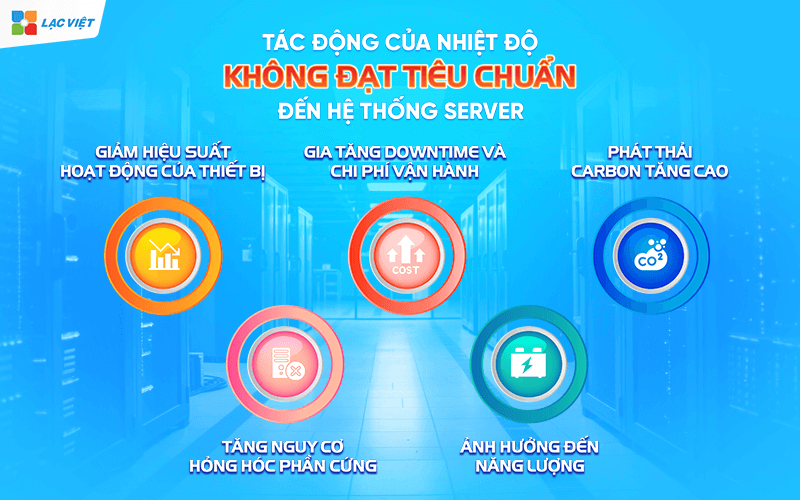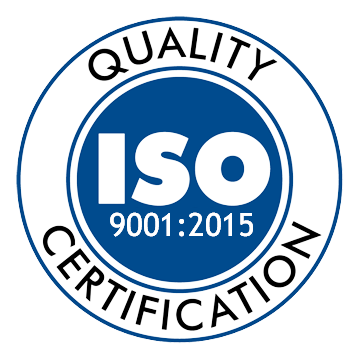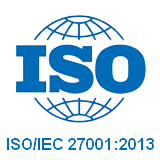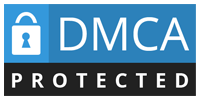In the digital era system server server plays an important role in infrastructure, information technology, business. Maintaining room temperature server in the standard not only ensures the performance, but also help increase equipment life, reduce risk of interrupting operation. However, many businesses still have not mastered the standard required temperature, leading to the losses significantly.
This article will Lac Viet Computing will provide comprehensive information on standard room temperature, serverfrom the importance, standard specific to the technology solutions support.
1. Standard room temperature, server what is?
Standard room temperature, server is specified about the ideal temperature to ensure the equipment in the server room, stable operation, safety and optimal performance. According to the recommendations of American Society of Heating, Refrigerating and Air-Conditioning Engineers (ASHRAE)temperature , server room, ideally located in the range from 18°C to 27°C (64,4°F to 80,6°F).
This standard not only help protect the hardware from overheating, but also minimize the risk of such failure, optimize operating costs and extend the life system.
Server room is where the focus of high-tech equipment such as servers, storage, network equipment. Not maintain the temperature in the safety threshold will be:
- According to research from Uptime Institute, the temperature exceeds the standards can reduce equipment life up to 50% due to the components of impaired quality.
- A survey of ITIC (Information Technology Intelligence Consulting) for see 76% of business recorded incidents server occurs due to temperature error exceeds the threshold.
- Equipment operation under high temperature will be prone to overload, lead to deterioration in performance.
- Increased risk of disruption system: System might experience bugs or stop functioning due to excessive heat, which causes interruption of business operations. The ideal temperature to help reduce the error rate of the system down to only 0,8%/yearwhile at temperatures higher than 5°C compared to standard, this rate increased 2,5%/year.
- Rising cost of repair and maintenance: Hardware failure usually occurs when the temperature exceeds the safety threshold, the cost is not worth having. A report by Schneider Electric (2023) shows the temperature maintained in the ideal can reduce maintenance costs up to 30%thanks reduce the load for the cooling system.
- Price server 2025 latest: comparison details according to your business needs
- Dell servers | Dell Poweredge Server genuine for the Titanium of Dell Technologies
- Advice configure server optimized for enterprise-scale, field
- Machine business owner should choose the kind? Quote the type of Server the most popular
2. Standard room temperature, server according to international regulations
Engineers association of Heat and cold air conditioning, United States (ASHRAE) has launched the international standards on room temperature server to ensure optimum performance for the system. Accordingly, the ideal temperature recommended range:
- From 18°C to 27°C: This is the limit optimized to ensure stable operation of the IT equipment.
- Relative humidity from 40% to 60%: Humidity is too high can cause the risk of condensation of water vapor, while the humidity is too low to lead to static damage components.
Performance:
- At temperatures below 18°C: the System may not operate efficiently because the components do not reach a state of heat ideal.
- On 27°C: the Risk of overheating, causing the CPU decreased pulse, causing a delay or loss of stability.
Business priority should periodically check system temperature control, ensure compliance with international standards. Investing in advanced technologies such as IoT, sensors, smart temperature, the cooling system modern not only help control the temperature effectively, but also bring peace of mind in the operating system server.
3. The factors affecting the room temperature, server
Room temperature server is affected from many factors, including the cooling system, space design, room, server, download the heat from the device. Below is the detailed analysis for business to understand to choose the right solution.

3.1. Cooling system (Cooling Systems)
The cooling system is the most important factor in maintaining room temperature, server stability. A cooling system efficiency not only helps to control the temperature but also save the energy, prolong the service life of equipment.
System air conditioner (CRAC/CRAH): The air-conditioning system, CRAC (Computer Room Air Conditioning) or CRAH (Computer Room Air Handler) is designed specifically for server room to provide cooling capacity accurate to control moisture effectively.
- CRAC use cooling technology based on compressed air, which is often applied in the server room standards.
- CRAH line use cool air from the system of cold water, more efficient in terms of energy but require the cost of the initial investment is high.
Cooling technology liquid (Liquid Cooling): This technology is becoming increasingly popular, especially in the large data center or server room, there are device density is high. Liquids have the ability to transmit heat faster than air cooling directly to the CPU, GPU and other components important.
- Effect: Reduction of operating temperature from 10°C to 15°C compared with air cooling.
- Energy saving: Reduce 30%-50% power consumption for the cooling system.
3.2. Design room server
Design space, server room, play a decisive role in the optimized airflow ensures uniform temperature between the regions.
Device layout optimal airflow (Hot aisle/Cold aisle): This method divide the rack into two separate areas:
- Cold aisle: Towards the front of the rack cabinet at the entrance where the cold air is supplied from the cooling system.
- Hot aisle: The back of the rack guide on the heated walkways, where hot gases are collected and taken out of the room.
Benefits: Reduce the average temperature in the server room. Save cooling costs up to 30%.
Insulation and room dimensions:
- Insulation material: Use wall insulation, doors sealed to prevent the intrusion of outside temperature.
- Room size: Server room that is too small will restrict airflow, causing the phenomenon of heat accumulation.
3.3. Download heat from the device
The heat generated from the device is also important factor affecting the room temperature, server.
The difference between the types of server:
- Blade server: With high-density blade server heat more than rack server and tower server. A blade server can generate the amount of heat from 4kW to 6kW on each rack.
- Rack server: In accordance with the business SME, the heat generated usually from 1.5 kW to 3kW on each rack.
The number of devices and download the work:
- The number of devices increases: Increased device density means increased heat load in the room server, requiring the cooling system to operate with greater capacity.
- Download high work: The server continuous operation at high power, as when handling big data (big data), or AI, will produce large amounts of heat than the common tasks.
Enterprises need to fully evaluate the factors that affect the temperature of the server room to design and operate the system accordingly. From the selection of cooling system design, space to manage the heat load from the device, each element plays an important role in maintaining the room temperature, server stability, protecting your IT assets long-term.
4. The impact of temperature does not reach the standard to server system
Nhiệt độ phòng server không đạt tiêu chuẩn có thể gây ra những hậu quả nghiêm trọng, không chỉ ảnh hưởng đến hiệu suất hoạt động của hệ thống mà còn làm tăng nguy cơ gián đoạn vận hành doanh nghiệp.

Dưới đây là những tác động cụ thể:
4.1. Reduce performance of the device
- Overheating (Overheating): The devices such as CPU, hard drives, power supplies operate continuously generate large amounts of heat. If the cooling system is not effective or ambient temperature exceeds 27°C, rising temperatures will trigger mechanism, reduce the pulse rate of the CPU (thermal throttling) to protect the hardware. This significantly reduces the processor performance data.
- Performance decreased abruptly: A study by Microsoft showed that when the temperature exceeds 30°C, the error rate data in system storage increased 25%.
4.2. Increase the risk of hardware failure
- Damage to electronic components: High temperature increases the thermal expansion of the components, causing cracked welds or circuit error. Hard drive HDD and SSD are particularly sensitive to high temperatures; according to data from Backblaze, the temperature exceeds 40°C reduce the lifespan of the hard drive at 15%-20%.
- Static electricity due to low humidity: Độ ẩm không đạt tiêu chuẩn (<40%) có thể tạo ra tĩnh điện, dẫn đến nguy cơ chập mạch hoặc hư hỏng linh kiện nhạy cảm.
4.3. Increased downtime and operating costs
- Increase the proportion of downtime: According to reports of Uptime Institute, 1°C increase above the standard can increase the rate of downtime up to 2% each year. Downtime not only cause disruptions that also affect the reputation, causing financial losses severe.
- Rising cost of repair replacement: When the temperature is not standardized, the components and hardware vulnerable to damage early, increasing maintenance costs. A study by IBM showed not maintain the ideal temperature increases the cost of hardware repairs up to 35% every year.
4.4. Affect energy and the environment
- Power consumption rising: When the room temperature, server exceeds the threshold, the cooling system must operate at full capacity, increases energy costs. Data from Schneider Electric to see the cooling system occupies 40%-50% of the total energy consumption of the server room.
- Carbon emissions: High energy consumption not only increases the cost but also increase CO2 emissions, affect is committed to protecting the environment of the business.
5. System, control room temperature, server efficiency
To ensure standard room temperature, serverbusinesses need to apply the control solution to effectively manage. Here are the specific measures:
5.1. Cooling system optimal
- Air conditioning system for professional use (Precision Cooling): Air conditioning, dedicated server room have the ability to control temperature, humidity exactly help maintain ideal conditions 24/7.
- The cooled stream of hot air – conditioning (Hot and Cold Aisle Containment): Dividing the area of hot air – cold in the server room to optimize airflow, reduce uneven temperatures. This pattern has been companies such as Google, Amazon apply to save up to 30% cooling energy.
- Liquid Cooling System: This is the advanced solution, using liquid cooling direct components, higher efficiency than the system air cooled transmission system.
5.2. Sensor temperature and humidity smart
- Sensor IoT: These sensors track temperature, humidity, real-time automatically send alert when exceeding the threshold standards help businesses react promptly to prevent the risk rising temperatures.
- Management system, automatic temperature: Use integrated software AI to adjust airflow, the operation of the system cooling based on the temperature data, the actual.
5.3. Periodic maintenance and suitable design
- Periodic maintenance cooling system: Sanitary inspection, periodic cooling devices, to ensure performance.
- Room design server sciences: Ensure space large enough to avoid temperature cornered department. Arrange a rack reasonable to optimize airflow.
5.4. App advanced technology
Modern technology plays an important role in the control of room temperature, server help improve operational efficiency, save energy.
AI and IoT in automatic temperature adjustment
- AI (artificial intelligence): The cooling system integrated AI can analyze data, temperature, heat load, air flow in real time to automatically adjust cooling capacity. Help reduce waste energy, preventing overheating in areas critical.
- IoT (Internet of Things): Sensors, IoT devices are installed at different positions in the server room for continuous monitoring of parameters such as temperature, humidity, air pressure. This data is sent on the control center to make timely adjustments, ensured temperature stability.
Benefits: Reduce energy consumption cooling to 20%-30%. Increase efficiency, temperature control in each zone in the server room.
5.5. Optimal energy cost
- Renewable energy sources: Applied solar or wind to provide power for the cooling system, just save costs and reduce carbon emissions.
- Optimize PUE (Power Usage Effectiveness): Track indicator PUE to assess the efficient use of energy, thereby improving the system. The PUE is the ideal under 1.5 according to the international standard.
6. Vietnam – a comprehensive Solution for server room business
To ensure standard room temperature, server, enterprises need to choose the professional partner in the design and construction of infrastructure systems. Cooperation with service provider reputation not only ensure quality but also bring solutions to optimize cost, efficiency long-term.
The importance of the cooperation with reputable vendors:
- Our team of professionals have the experience to ensure fit design operating needs of the business.
- Comprehensive review about the location, heat load and the specific requirements of the IT system to the proposed cooling solution the most effective.
- Maintenance support system upgrades periodically, reduce risk damage due to temperature.
Lac Viet is the pioneer in the field of design, construction, system, server room international standard:
In-depth experience: More 30 years of experience with a team of professional technicians, understanding the standard temperature cooling modern.
Comprehensive solution:
- Design consultants cooling system in accordance with the scale, the peculiarities of each business.
- Deployment of advanced technologies such as AI, IoT, liquid-cooled.
- Provide service, maintenance, continuous optimization after construction.
- Solution provider FIRE protection server room with technology F200 most advanced
Vietnam has successfully implemented hundreds of projects room server help businesses reduce operating costs, enhance system performance.
>>> Giải pháp liên quan: Xem báo giá máy chủ Server Dell for business
Maintaining standard room temperature, server is a core element to ensure the system IT works stable and sustainable. Businesses not only need to apply the advanced technology, but also need to cooperate with unit design and construction of prestige such as Vietnam to optimize efficiency and minimize risk in the operation.













